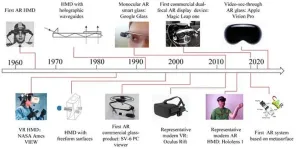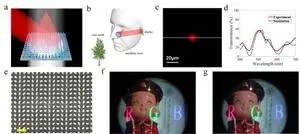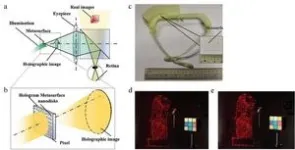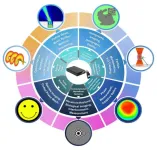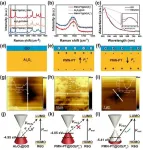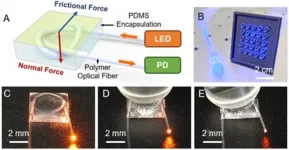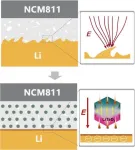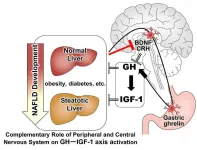A new publication from Opto-Electronic Science; DOI 10.29026/oes.2023.230025 discusses near-eye display based on metasurface devices.
With the rise of the meta-universe, virtual reality (VR) and augmented reality (AR) technologies have been developing rapidly in recent years. Near-eye displays are crucial technologies for VR and AR. Despite the rapid advances in near-eye display technologies, there are still challenges such as large field of view (FOV), high resolution, high image quality, natural free 3D effect, and compact form factor. Great efforts have been devoted to striking a balance between visual performance and device compactness. While traditional optics are nearing their limitations in addressing these challenges, ultra-thin metasurface optics, with their high light-modulating capabilities, may present a promising solution.
With the development of metasurface technology, novel metasurface devices have been applied for AR/VR near-eye display systems. To summarize the progress of metasurface for near-eye display applications in recent years, a team from Shanghai Jiao Tong University reviewed the latest progress of near-eye display based on metasurface devices.
As shown in Figure 1, near-eye display technologies have witnessed rapid development over the past six decades since the introduction of the first AR HMD device in the 1960s. Familiar devices like Hololens and Apple Vision Pro are revolutionizing our lives. In 2018, metasurface devices were first proposed for near-eye displays. Metasurfaces, ultra-thin planar elements consisting of sub-wavelength antennas, offer superior modulation capabilities for light amplitude, phase, and polarization state, outperforming conventional refractive and diffractive optics. Extensive research has been conducted on optical metasurface devices, including gratings, lenses, and holograms. Metasurfaces are promising candidates as key components in near-eye displays to replace bulky conventional optics or enable novel functionalities, paving the way for next-generation AR and VR technologies.
In this review, the authors first introduce VR and AR near-eye displays, and then briefly explain the working principles of light-modulating metasurfaces, review recent developments in metasurface devices geared toward near-eye display applications, delved into several advanced natural 3D near-eye display technologies based on metasurfaces. The architecture of a VR display is relatively straightforward, composed of two main functional components: the image source and the eyepiece. In theory, metasurface devices could serve as either the image source or the eyepiece. However, for VR displays, the image source must provide large-size, video-rate, full-color images to create an immersive virtual environment. This requirement surpasses the capability of the state-of-art metasurfaces. Therefore, the application of metasurfaces in VR displays is primarily restricted to functioning as an eyepiece.
Given their versatile functionality, high optical performance and ultra-thin form factors, metasurfaces have been proposed as critical optical components in various AR display architectures. They can function as eyepieces, combiners, and more, substituting traditional bulky optics or integrating new advanced optical functionalities, to achieve more compact and lightweight, high image-quality and large FOV AR displays. The authors reviewed the applications of metasurfaces in different AR architectures, based on beam splitters, waveguides and direct projection. As depicted in Figure 2, a multifunctional visor can simultaneously perform as an eyepiece for the oblique virtual image light and as a combiner that reflects the virtual image light into the viewer’s eye while transmitting light from the real environment.
Metasurfaces hold great potential for applications in VR and AR near-eye displays to improve imaging performance, enlarge FOV or increase compactness. However, most near-eye displays still employ stereoscopic 3D display technology, which can lead to vergence-accommodation conflict (VAC) and visual fatigue. To address this issue, natural 3D display approaches have been proposed, including Maxwellian viewing display, holographic display, light field display, and multi-/vary-focal displays. Thanks to the versatility of metasurfaces, metasurface devices have been employed as important optical elements in these advanced 3D near-eye displays to help alleviate visual fatigue and provide a more natural 3D visual experience. Figure 3 shows a Maxwellian-viewing near-eye display that can provide accommodation-free virtual images by using a Huygens’ metasurface hologram as the display device.
This review provides an extensive overview of the recent advancements in the applications of metasurfaces for near-eye displays. Thanks to their ultra-thin form factors and exceptional flexibility in light modulation, metasurfaces offer a promising solution for the development of compact and lightweight VR/AR headsets.
# # # # # #
Yan Li group from Shanghai Jiao Tong University has been committed to the field of display. Their research interests include AR/VR display, liquid crystal devices, 3D display and so on. In the field of display, the team has won many distinguished student paper awards, distinguished paper awards at ICDT conference, and JSID Outstanding Student Paper Award, and has published more than 100 papers in the field of display and optics.
Yan Li, Associate professor and Chenxing Scholar of Shanghai Jiao Tong University. Her research interests include augmented reality displays, 3D displays, liquid crystal devices and so on. She has published more than 100 papers in journals and conferences in the optics and display areas. She has been serving as technical committee members for international conferences including SID Display Week, SPIE Photonics West and International Conference on Display Technology. She had been an associate editor for Optics Express and is currently the associate editors for IEEE Photonics Journal and Journal of Society for Information Display.
Xiaojin Huang, Shanghai Jiao Tong University, Ph.D. student in the Department of Electronic Engineering. Her research interests include liquid crystal devices and their application in AR displays.
Shuxin Liu, Postdoc of Shanghai Jiao Tong University, his research interests include liquid crystal devices, AR/VR display technology and so on. He has published more than 20 SCI papers in the field of display. He is currently guest editor of Crystals.
Dr. Haowen Liang is an associate professor at the School of Physics, Sun Yat-sen University. His research interests include optical imaging by metalenses, virtual reality and augmented reality, and optical scattering imaging. He publishes more than 40 academic papers in SCI recognized journals including PhotoniX, Nano Letters, Optica, Laser & Photonics Reviews, and Photonics Research. His research on ultrahigh numercal aperture silicon metalens is recognized as the OPTIC 2018 by Optica (formerly OSA).
# # # # # #
Opto-Electronic Science (OES) is a peer-reviewed, open access, interdisciplinary and international journal published by The Institute of Optics and Electronics, Chinese Academy of Sciences as a sister journal of Opto-Electronic Advances (OEA, IF=9.682). OES is dedicated to providing a professional platform to promote academic exchange and accelerate innovation. OES publishes articles, reviews, and letters of the fundamental breakthroughs in basic science of optics and optoelectronics.
# # # # # #
More information: https://www.oejournal.org/oes
Editorial Board: https://www.oejournal.org/oes/editorialboard/list
OES is available on OE journals (https://www.oejournal.org/oes/archive)
Submission of OES may be made using ScholarOne (https://mc03.manuscriptcentral.com/oes)
CN 51-1800/O4
ISSN 2097-0382
Contact Us: oes@ioe.ac.cn
Twitter: @OptoElectronAdv (https://twitter.com/OptoElectronAdv?lang=en)
WeChat: OE_Journal
# # # # # #
Li Y, Huang XJ, Liu SX, Liang HW, Ling YY et al. Metasurfaces for near-eye display applications. Opto-Electron Sci 2, 230025 (2023). doi: 10.29026/oes.2023.230025
END
